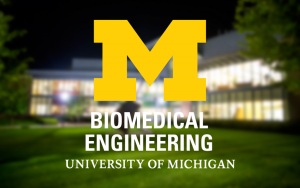Presented By: Biomedical Engineering
BME 500 Seminar: George Christ
Development and Evaluation of Tissue Engineering/Regenerative Medicine technologies for treatment of volumetric muscle loss injuries

Despite the well-documented capability of skeletal muscle to repair, regenerate, and remodel following injury, there remain a multitude of diseases, disorders, and traumatic injuries that result in irrecoverable loss of muscle structure and function. For example, volumetric muscle loss (VML) injuries are characterized by a degree of composite muscle tissue loss so severe, that it exceeds the native ability of the muscle to repair, thereby resulting in permanent cosmetic and functional deficits to the limbs, neck, or face. These injuries significantly impact both the civilian and military populations. Current treatment for VML injury involves surgical muscle transfer, although these procedures are often associated with both poor engraftment and donor site morbidity, as well as incomplete cosmesis and functional recovery. Not surprisingly, this unmet medical need has stimulated research efforts to develop new technologies for treatment of VML injuries. Recent attention has focused on development of tissue engineering (TE)/regenerative medicine (RM) technologies to provide more effective treatment options for large scale muscle injuries. A variety of preclinical approaches have been tried that include implantation of synthetic and/or natural extracellular matrices/scaffolds/constructs at the site of VML injury, both with and without a cellular component. Extant data indicate that the inclusion of a cellular component generally leads to a greater degree of functional improvement. Consistent with these preclinical results, recent clinical studies for treatment of VML injury, solely with implanted decellularized extracellular matrix scaffolds, have provided evidence for modest functional recovery but with little de novo muscle tissue regeneration at the injury site. More recently, bio-printed tissue engineered constructs and their potential applications to treatment of VML injury have been reported in the literature. While these initial clinical and preclinical observations are encouraging for the TE/RM paradigm, full structural and functional recovery has yet to be achieved, and thus, there remains significant room for therapeutic advancement. To this end, I will describe our highly collaborative efforts to boost development and evaluation of a range of implantable regenerative therapeutics (biomaterials and tissue engineered constructs) in biologically relevant animal models. The overall goal is to increase the efficiency of clinical translation of TE/RM technologies capable of more complete functional recovery following repair of VML injury.
ZOOM LINK: https://umich.zoom.us/j/94405051853
ZOOM LINK: https://umich.zoom.us/j/94405051853